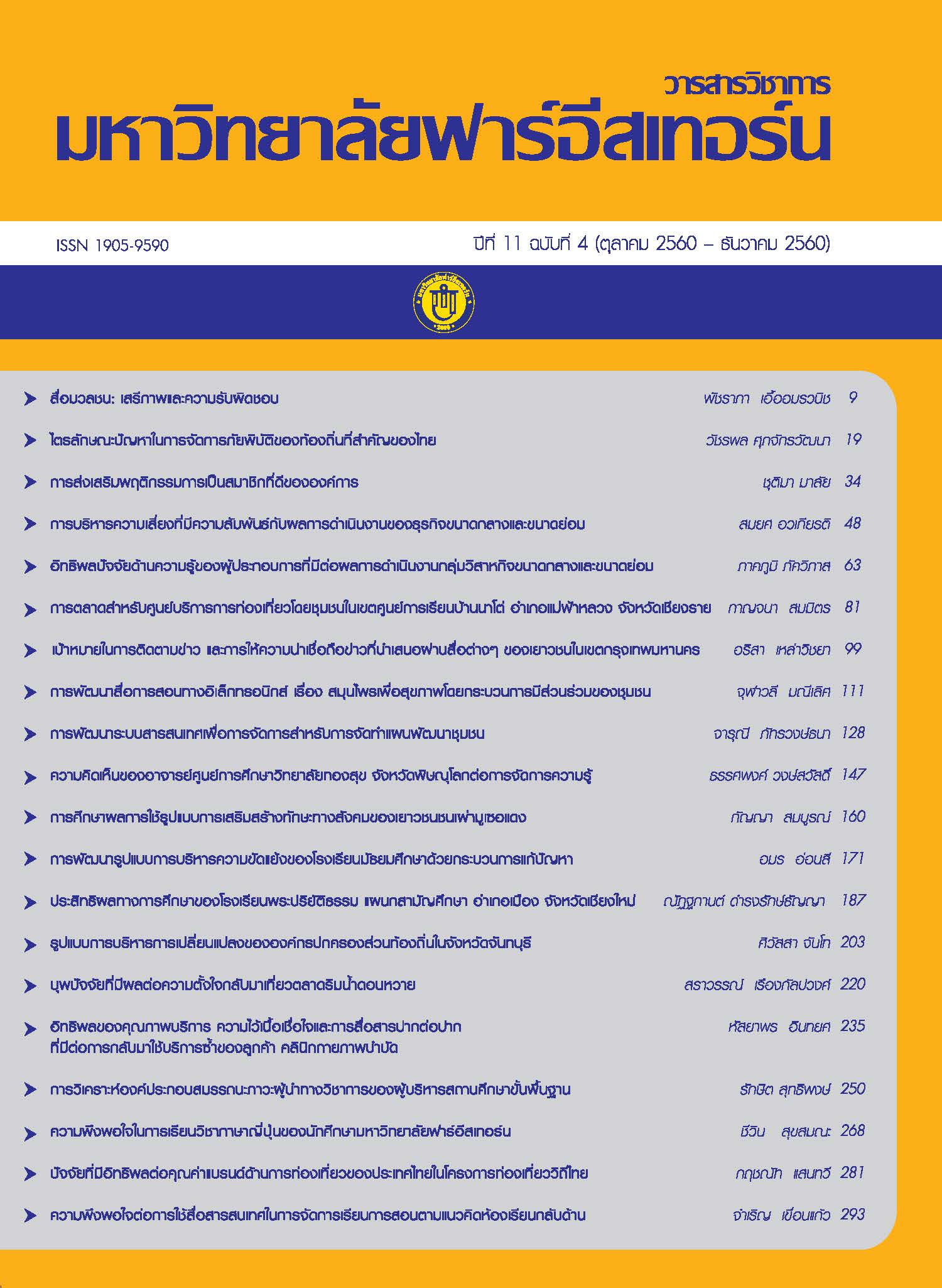การบริหารความเสี่ยงที่มีความสัมพันธ์กับผลการดำเนินงาน ของธุรกิจขนาดกลางและขนาดย่อมในจังหวัดปทุมธานี
Main Article Content
Abstract
วัตถุประสงค์การวิจัยครั้งนี้ คือ (1) เพื่อศึกษาความคิดเห็นเกี่ยวกับการบริหารความเสี่ยงและ
ผลการดำเนินงานของธุรกิจขนาดกลางและขนาดย่อมในจังหวัดปทุมธานี และ (2) เพื่อศึกษาความสัมพันธ์
ระหว่างการบริหารความเสี่ยงที่มีต่อผลการดำเนินงานของธุรกิจขนาดกลางและขนาดย่อม (SMEs)
กลุม่ ตัวอยา่ ง คอื ผบู้ ริหารหรือเจา้ ของธุรกิจ SMEs ทจี่ ดทะเบียนเปน็ นิตบิ คุ คลในจังหวัดปทุมธานี จาํ นวน 218 ราย
ใชว้ ธิ กี ารสุม่ ตัวอยา่ งแบบชว่ งชนั้ (Stratified Random Sampling) แบง่ ตามประเภทของธุรกิจ ใชแ้ บบสอบถาม
เป็นเครื่องมือในการเก็บรวบรวมข้อมูล สถิติเชิงพรรณนา ได้แก่ ค่าเฉลี่ย ค่าส่วนเบี่ยงเบนมาตรฐาน
สถิติอนุมานทดสอบสมมติฐานใช้การวิเคราะห์สหสัมพันธ์แบบพหุคูณ และการวิเคราะห์ความถดถอยแบบ
พหุคูณ
ผลการวิจัยพบว่า ธุรกิจ SMEs ในจังหวัดปทุมธานี ส่วนใหญ่มีรูปแบบธุรกิจเป็น บริษัท จำกัด ประกอบ
ธุรกิจด้านต่างๆ ได้แก่ ขนส่ง ประกัน นำเข้า-ส่งออก ระยะเวลาในการดำเนินงานส่วนใหญ่มากกว่า 15 ปี
ทุนจดทะเบียนปัจจุบัน ส่วนใหญ่ตํ่ากว่า 30,000,000 บาท และส่วนใหญ่มีจำนวนพนักงานตํ่ากว่า 50 คน
ความคิดเห็นเกี่ยวกับการบริหารความเสี่ยง ทั้ง 5 ด้าน อยู่ในระดับมาก เรียงตามลำดับค่าเฉลี่ยได้ ดังนี้
(1) ด้านการกำหนดวัตถุประสงค์ ( = 4.02) (2) ด้านการระบุความเสี่ยง (
= 3.91) (3) ด้านการจัดการ
ความเสี่ยง ( = 3.89) (4) ด้านการติดตามประเมินผลและการรายงาน (
= 3.88) และ (5) ด้านการประเมิน
ความเสี่ยง ( = 3.78) ตามลำดับ โดยมีความคิดเห็นเกี่ยวกับผลการดำเนินงาน ทั้ง 4 ด้าน อยู่ในระดับมาก
เช่นเดียวกัน เรียงตามลำดับค่าเฉลี่ยได้ดังนี้ (1) ด้านลูกค้า ( = 4.10) (2) ด้านการเรียนรู้และพัฒนา
( = 3.88) (3) ด้านกระบวนการภายใน (
= 3.87) และ (4) ด้านการเงิน (
= 3.61) ตามลำดับ นอกจากนี้
ผลการวิจัยยังพบว่า การบริหารความเสี่ยงในด้านการระบุความเสี่ยง ด้านการประเมินความเสี่ยง ด้านการ
จัดการความเสี่ยงและด้านการติดตามประเมินผลและการรายงานมีความสัมพันธ์และมีผลกระทบเชิงบวก
กับผลการดำเนินงานโดยรวมของธุรกิจ SMEs ซึ่งหมายความว่า หากธุรกิจ SMEs สามารถบริหารความเสี่ยง
ในทุกๆ ด้านได้ดี ก็จะทำให้ผลการดำเนินงานของธุรกิจ SMEs ดีขึ้นด้วย เช่นเดียวกัน
The purpose of this research is: (1) To study the opinion of the risk management and
performance of small and medium enterprises (SMEs) in Pathumthani province; and (2) To study
the relationship between risk management and the performance results of the SMEs. The samples
were SMEs entrepreneurs or owners registered as company or partnership in Pathumthani province,
218 samples by stratified random sampling with classified by type of business. Questionnaires were
used to collect data. Statistics used in data analysis were descriptive statistics were mean,
standard deviation and statistics for hypothesis testing were Multiple Correlation Analysis and
Multiple Regression Analysis.
The results found that, most of SMEs in Pathumthani province had business type as
a company limited operating in many section including transportation, insurance, import-export.
Most of the companies established over 15 years and had their registered capital less than
30,000,000 Baht and the number of employees was less than 50. The opinions on risk management
in all five aspects were at a high level which could be ranked by mean as (1) Objectives Setting
( = 4.02) (2) Risk Identification (
= 3.91) (3) Risk Management (
= 3.89) (4) Monitoring
Evaluating and Reporting ( = 3.88) and (5) Risk Assessment (
= 3.78) respectively. The opinions
on the performance of the four aspects were at a high level too which could be ranked by mean as
(1) Customer Perspective ( = 4.10) (2) Learning and Growth Perspective ( = 3.88) (3) Internal
Process Perspective ( = 3.87) and (4) Financial Perspective (
= 3.61) respectively. Moreover,
the results were found that Risk management in Risk Identification, Risk Assessment, Risk Management,
Monitoring Evaluating and Reporting had a positive relationship and had a positive impact on the
overall performance of small and medium enterprises. This means if SMEs could manage well risk
in all aspects, it would also improve the performance of SMEs as well.
Article Details
1. Any views and comments in the Journal of Social Innovation and Lifelong Learning are the authors’ views. The editorial staff have not to agree with those views and it is not considered as the editorial’s responsibility.
2. The responsibility of content and draft check of each article belongs to each author. In case, there is any lawsuit about copyright infringement. It is considered as the authors’ sole responsibility.
3. The article copyright belonging to the authors and The Far Eastern University are copyrighted legally. Republication must be received direct permission from the authors and The Far Eastern University in written form.
References
จันทนา สาขากร นิพันธ์ เห็นโชคชัยชนะ และ ศิลปพร ศรีจันเพชร (2550). การควบคุมภายในและการตรวตสอบภายใน, กรุงเทพมหานคร: ทีพีเอ็น เพรส.
นฤมล สะอาดโฉม (2550). การบริหารความเสี่ยงองค์กร Enterprise risk management, กรุงเทพมหานคร: ฐานบุ๊คส์
นิธินันท์ ทองอุ่น (2553). ผลกระทบของประสิทธิภาพการบริหารความเสี่ยงทางการเงินที่มีต่อผลการดำเนินงานของธุรกิจ SMEs ในเขตภาคตะวันออกเฉียงเหนือ,วิทยานิพนธ์ บช.ม. มหาสารคาม: มหาวิทยาลัยมหาสารคาม.
บุญชม ศรีสะอาด (2556). การวิจัยเบื้องต้น ฉบับปรับปรุงใหม่. พิมพ์ครั้งที่ 9. กรุงเทพมหานคร: สุวีริยาสาส์น.
พรตพร อาฒยะพันธุ์ (2550). ผลกระทบของประสิทธิภาพการบริหารความเสี่ยงที่มีต่อผลการดำเนินงานของธุรกิจ SMEs ในเขตกรุงเทพมหานคร. วิทยานิพนธ์: กจ.ม. มหาสารคาม: มหาวิทยาลัยมหาสารคาม.
พสุ เตชะรินทร์ (2548). เส้นทางจากกลยุทธ์สู่การปฏิบัติด้วย Balanced Score Card. กรุงเทพมหานคร : โรงพิมพ์แห่งจุฬาลงกรณ์มหาวิทยาลัย.
อุษณา ภัทรมนตรี (2547). การตรวจสอบและการควบคุมภายใน แนวคิดและกรณีศึกษา. กรุงเทพมหานคร: มหาวิทยาลัยเกษตรศาสตร์.
Beasley, Clune and Hermansom (2005). Enterprise Risk Management: An empirical analysis of factors associated with the extent of implementation. Journal of Accounting and Public Policy. 24, 521- 531.
Godfrey, P.C., Merrill, C.B. and Hansen, J.M. (2009). The relationship between corporate social responsibility and shareholder value: an empirical test of the risk management hypothesis. Strategic Management Journal, 30(4), 424 – 445.
Hair, J.F., Black, W.C., Babin, B.J. and Anderson, R.E. (2014). Multivariate data analysis. 7th ed., London: Pearson Education Inc.
Pricewaterhouse Cooper (2004). COSO ERM: Enterprise Risk Management. retrieve on December 11, 2016, from https://www.coso.org/Documents/990025P-Executive-Summary-final-may20.pdf.

